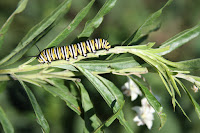Monarch Butterflies and Milkweed
 |
| Monarch butterfly caterpillar |
 |
| Aphids on milkweed |
I leave them on the plants for their predators to eat and parasitize. Wasps and Lady Beetles and their larvae are ones we most
commonly think of as their predators.
Pirate bugs and Syrphid Fly larvae also eat aphids
 |
| Ladybug on milkweed |
Then there's the Milkweed Tussock Moth caterpillar, Euchaetes egle, that eats milkweed leaves. Cute as they are, they are eating Monarch caterpillars' food and I wish they wouldn't.
 |
| Tussock Moth Caterpillar |
This year we have swamp milkweed, tropical milkweed and balloon milkweed in the garden for Monarch caterpillars. The balloon milkweed is the number one favorite with swamp milkweed coming in second. The tropical milkweed is being largely ignored.
That outcome is fine with me since the other two are infinitely easier to grow in our climate and soil.
 |
| Swamp Milkweed Leaf Beetle |
The milkweed flower and leaf eaters include Swamp Milkweed Leaf Beetle. They spend the winter in Mullein leaves (must be cozy in a nest of those fuzzy leaves) and emerge when there is food available.
 |
| Milkweed Bug |
So they are only a serious pest to you and the plant if you want a lot of seeds for next year.
 |
| European brown mantis |
other stuff, too. Hummingbirds, mice, snakes - all on their menu. Yum.
And, well, they will eat the Monarch butterflies when they come to the milkweed to lay eggs, too. But, they also eat their own small mantis cousins so what can you say?
 |
| Monarch butterfly eggs on milkweed leaf |
You may have to click on the images to see them large enough for your eyes. Feel free to look.
If you use my images, though, please credit me. Thanks.
Update two days later - 6 more eggs laid today.


Comments
I usually place cuttings into damp sterile potting soil rather than in the ground since our weather and ground temperatures are unpredictable at this time of year.
For sedum cuttings, I would mix potting soil with some sand or vermiculite to increase drainage, remove the growth from the bottom two inches and carefully tuck the cutting in.
The container would be kept inside, protected from direct light and would probably make roots in about a month.
I don't know where you are gardening - which zone, etc.
Martha